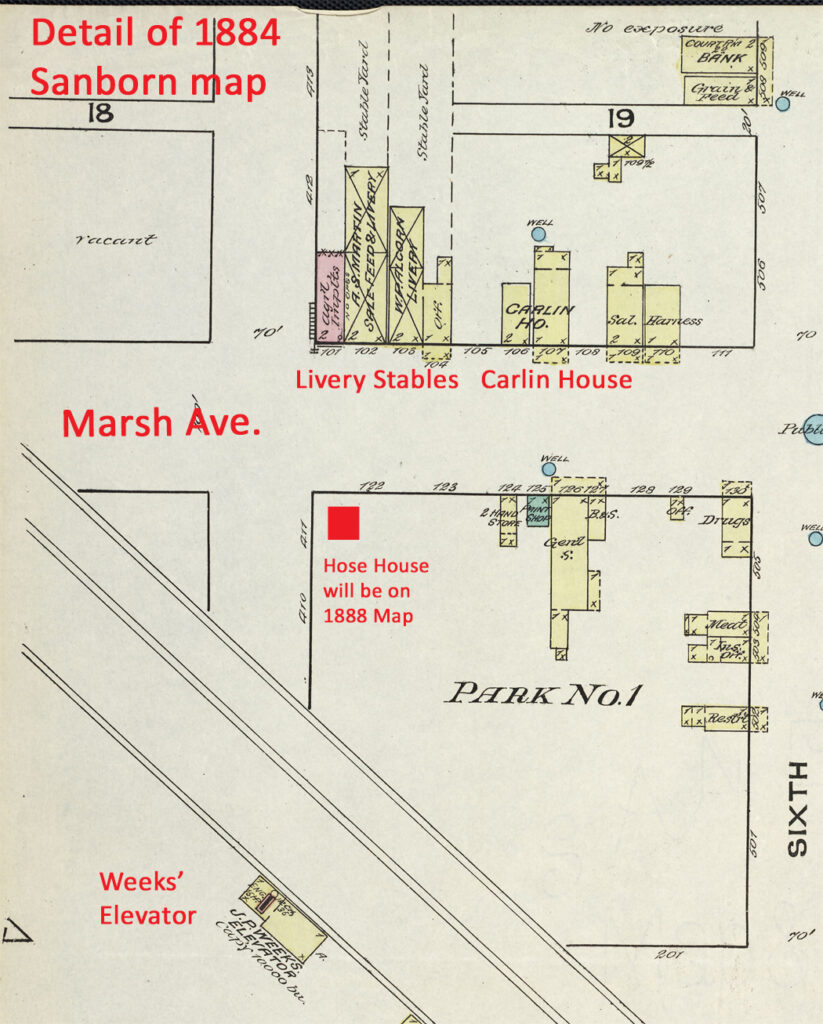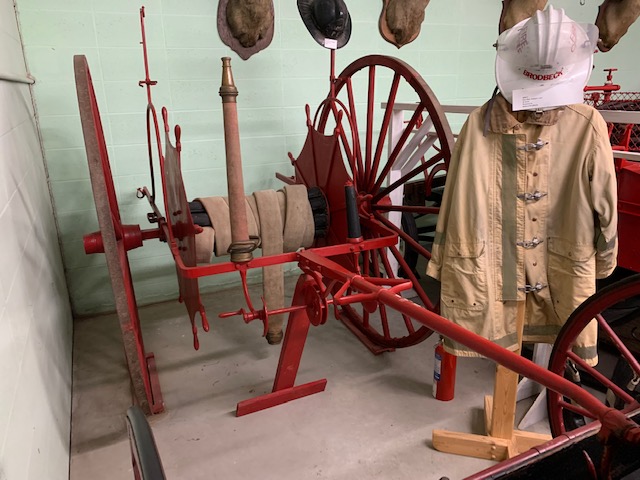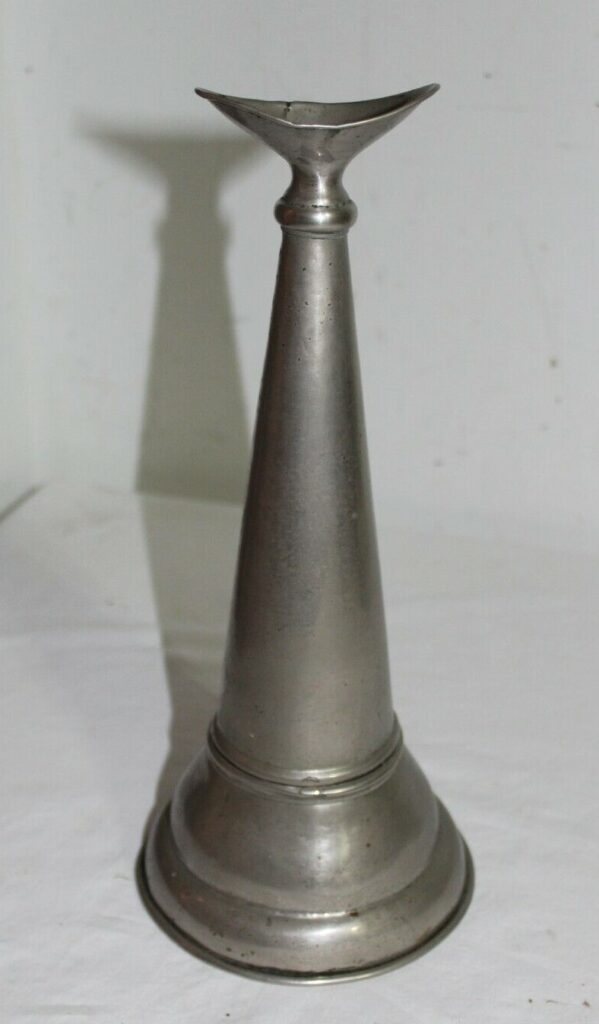Part 1 of this series described a fire-plagued week in Kinsley in early January, 1880. When the Hart home burned to the ground that week, over one hundred men carried buckets of water to prevent the buildings and nearby prairie from catching fire.
The next month “The city fathers erected an engine house on the square and bought an engine and a hook and ladder truck.” The “square” referred to was the triangular block formed north of Sixth street and enclosed by Colony Ave., Marsh Ave. and the railroad tracks. Besides the ladders, this truck probably carried axes, pry bars, picks, and leather buckets.
A “hook and ladder” describes a roof ladder that had spring loaded hooks on the tip which could turn perpendicular to the ladder so it could lay flat. The hooks would then grab the roof ridge and hold the ladder in place enabling firefighters to work off the ladder with better footing on steep pitched and wet roofs. These ladders, as well as poles with hooks, were also used to pull down burning material to keep the fire from spreading.
The March 13, 1884, issue of the Kinsley Mercury describes the most destructive fire in western Kansas to that date. It was started by a spark from a locomotive as it was nearing Offerle. It was spread by a “hurricane” wind from the south which changed from the west, so that the flames “swept eastward in the direction of Kinsley with frightful rapidity leaving only death and destruction in their path…. houses, barns, windmills, farm implements, hundreds of cattle, grain and feed were lost.” A number of people narrowly escaped death and many were seriously injured. If the wind had shifted again, nothing could have saved Kinsley, but it ran one mile north of Kinsley and on east. The words in the Mercury echo down to us this winter, “There is nothing much worse than a big prairie fire when it once gets under headway with a high wind behind it.”
This series will be making use of Sanborn maps which are detailed maps of U.S. cities and towns in the 19th and 20th centuries. They were created to allow fire insurance companies to assess their liability. The October 1884 Sanborn map describes Kinsley (population 500) as having nothing but ladders and buckets for fighting fires. There was no steam and no hand engines, no independent hose carts, and no water facilities.

Detail of Marsh Ave. area on 1884 Sanborn map. Designations in red added for clarity. Sanborn maps are freely available on line from the Library of Congress. https://www.loc.gov/collections/sanborn-maps
When the Weeks’ Elevator burned to the ground (located in area of present elevators) the following appeared in the December 11, 1886 issue of the Kinsley Mercury: “We hope that this will arouse the people of Kinsley to the danger they are constantly in of being burned out of house and home. The city is large enough to build water works without their cost and maintenance being a very burdensome tax. If we do not have them built, the day will surely come when those who are opposed to the measure will stand beside the blackened ruins of their business houses or home and bitterly repent when it is too late.”
The city council responded and seven months later, on July 7, 1887 a bond issue to install water mains and hydrants in the city was passed nearly unanimously. Work began laying the mains in November.
On December 1, 1887, the Carlin House hotel was set on fire by an arsonist and burned to the ground. It was located on Marsh Ave about where Fireside Realty is today.

That month, the city ordered two hose carts and 1200 feet of 2 ½” hose. The plan was to keep one cart on each side of the railroad tracks. Two volunteer hose companies would be organized: Eagle Company on the south and Elk Company on the north. The carts arrived on February 10th. The city also purchased two “elegant fire trumpets” which the fire chiefs would use as megaphones to instruct the volunteers.
On February 15, 1888 the fire hydrants were in place and the water mains were turned on. However, this did not save two large livery barns owned by Ed Watrous and W. P. Alcorn when on April 12th another nighttime fire, perhaps started by a tramp, burned them down. They were located just north of where the Carlin House had been on Marsh Avenue.
The fire was not discovered until both stables were ablaze. “The fire companies were on the ground fully 10 minutes before there was pressure sufficient to throw a stream of water, and for a while it looked as if the row of frame buildings on the opposite side of the street would have to go. One building did catch fire, but fortunately by that time the water from the mains was available.” Eighteen horses, 18 head of cattle, feed, and implements were lost.
The next Sanborn Insurance map in 1888 shows that progress had been made to fight fires in growing Kinsley, population 1000. The map reports that there still were no steam and no hand engines, but two independent hose carts (or reels) and ladders were now located in a building on Marsh Ave (Frame Law Office today).
Sometime in the 1880s an “inadequate” bell had replaced the iron triangle for the city fire alarm. There is mention of it on the roof of the Edwards and Nobel dry goods store which is Circle K Auto Parts today. Coincidentally, our fire chief Larry Myers owns that building as did his fire chief father, Niles, before him.
The story continues next week with the addition of a proper fire station and bell.

